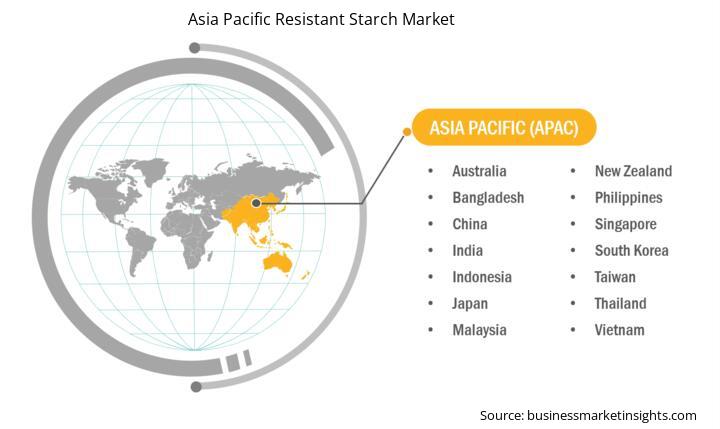Asia Pacific Resistant Starch Market Report (2021-2031) by Scope, Segmentation, Dynamics, and Competitive Analysis
No. of Pages: 168 | Report Code: BMIRE00032128 | Category: Food and Beverages
No. of Pages: 168 | Report Code: BMIRE00032128 | Category: Food and Beverages
The Asia Pacific resistant starch market size is expected to reach US$ 7,404.56 million by 2031 from US$ 4,390.18 million in 2023. The market is estimated to record a CAGR of 6.8% from 2023 to 2031.
China, India, Japan, and Australia are a few contributors to the resistant starch market growth in Asia Pacific. The market in Asia Pacific is witnessing robust growth, driven by increasing consumer awareness about its health benefits and a growing demand for functional foods. Also, the rising health-conscious middle-class population of China is driving the demand for fiber-enriched products. The growing food processing sector and the rising chronic conditions such as diabetes, which affects over 100 million people, are also major factors boosting the demand for resistant starch in India. Functional foods, including resistant starch, are majorly consumed by the aging population in Japan, which support better digestive and metabolic health.
Food manufacturers in Asia Pacific are incorporating resistant starch into a range of products such as bread, cereals, pasta, and dairy alternatives. The market is also benefiting from innovations in food processing technologies that allow for better incorporation of resistant starch into products without altering taste or texture. Furthermore, the focus on clean-label and plant-based products is driving the use of naturally derived resistant starch from sources such as corn, potatoes, and bananas.

Key segments that contributed to the derivation of the Asia Pacific resistant starch market analysis are form, type, and application.
Hectic work schedules and extended working hours have led people to pay less attention to their daily diet, health, and fitness. The lack of a proper diet might lead to various health issues, such as obesity, diabetes, and digestive problems. As a result, people are becoming more focused on preventive health and dietary supplements that offer health benefits without harmful effects. Prebiotics-infused supplements nourish human gut flora and significantly boost their metabolic activity, thereby improving digestion, nutrition absorption, and immune systems while inhibiting harmful microbe growth. Resistant starch as a prebiotic ingredient helps prevent obesity by positively stimulating fermentation by gut microbiota. Resistant starches enhance the body's ability to respond to insulin, enabling the body to manage high blood sugar and reducing the risk of type 2 diabetes, Alzheimer's disease, and heart disease.
Resistant starch used in dietary supplements creates good bacteria after fermentation in the large intestine. This leads to less constipation, lower cholesterol levels, and lower risk of colon cancer. After the onset of the COVID-19 pandemic, there has been a sharp rise in the popularity of functional foods and dietary supplements, as people have been prioritizing their health and actively searching for healthy alternatives. Dietary supplements formulated with resistant starch improve digestion and nutrient absorption and help lower the risk of digestive diseases. Further, consistent and adequate intake of prebiotics lowers the risk of cardiovascular diseases, including coronary heart disease, by reducing low-density lipoprotein (LDL) levels. Thus, rising awareness about preventive health among consumers fuels the resistant starch market growth.
Based on country, the Asia Pacific resistant starch market comprises Australia, China, India, Japan, South Korea, and the Rest of Asia Pacific. China held the largest share in 2023.
China, as one of the largest producers of agricultural products, particularly corn, has leveraged its agricultural resources to manufacture resistant starch at scale. China plays a pivotal role in this expansion owing to rising awareness regarding digestive health benefits and obesity management. According to NIH, in China, the obesity rate in men was approximately 10%, and in women, it was ~8% in 2023. The Government of China has also promoted healthier dietary habits through initiatives that encourage the consumption of low-glycemic index foods, further boosting the demand for resistant starch. In 2023, the use of resistant starch in bakery products and snacks was notably high, especially among urban consumers seeking healthier alternatives. The growing interest in clean-label ingredients and dietary fibers is also propelling the market, with companies in China investing in research and development to expand their product portfolios. Further, the imports of resistant starch into China are also growing, reflecting a reliance on this ingredient in various food applications.
| Report Attribute | Details |
|---|---|
| Market size in 2023 | US$ 4,390.18 Million |
| Market Size by 2031 | US$ 7,404.56 Million |
| CAGR (2023 - 2031) | 6.8% |
| Historical Data | 2021-2022 |
| Forecast period | 2024-2031 |
| Segments Covered |
By Form
|
| Regions and Countries Covered | Asia Pacific
|
| Market leaders and key company profiles |
|
Some of the key players operating in the market include Tate & Lyle Plc, Archer-Daniels-Midland Co, Cargill Inc, Ingredion Inc, Arcadia Biosciences Inc, Roquette Freres SA, MGP Ingredients Inc, American International Foods Inc, Crespel & Deiters GmbH & Co KG, Agrana Beteiligungs AG, Lehmann Food Ingredients Ltd, KMC Amba, Emsland-Stärke GmbH, Kono Chem Co Ltd, and BS Starch Chemical Co Ltd among others. These players are adopting various strategies such as expansion, product innovation, and mergers and acquisitions to provide innovative products to their consumers and increase their market share.
The following methodology has been followed for the collection and analysis of data presented in this report:
The research process begins with comprehensive secondary research, utilizing both internal and external sources to gather qualitative and quantitative data for each market. Commonly referenced secondary research sources include, but are not limited to:
Note: All financial data included in the Company Profiles section has been standardized to USD. For companies reporting in other currencies, figures have been converted to USD using the relevant exchange rates for the corresponding year.
The Insight Partners conducts a significant number of primary interviews each year with industry stakeholders and experts to validate its data analysis and gain valuable insights. These research interviews are designed to:
Primary research is conducted via email interactions and telephone interviews, encompassing various markets, categories, segments, and sub-segments across different regions. Participants typically include:

The Asia Pacific Resistant Starch Market is valued at US$ 4,390.18 Million in 2023, it is projected to reach US$ 7,404.56 Million by 2031.
As per our report Asia Pacific Resistant Starch Market, the market size is valued at US$ 4,390.18 Million in 2023, projecting it to reach US$ 7,404.56 Million by 2031. This translates to a CAGR of approximately 6.8% during the forecast period.
The Asia Pacific Resistant Starch Market report typically cover these key segments-
The historic period, base year, and forecast period can vary slightly depending on the specific market research report. However, for the Asia Pacific Resistant Starch Market report:
The Asia Pacific Resistant Starch Market is populated by several key players, each contributing to its growth and innovation. Some of the major players include:
The Asia Pacific Resistant Starch Market report is valuable for diverse stakeholders, including:
Essentially, anyone involved in or considering involvement in the Asia Pacific Resistant Starch Market value chain can benefit from the information contained in a comprehensive market report.